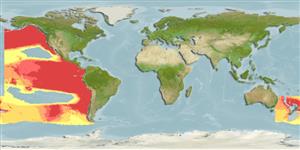Environment: milieu / climate zone / depth range / distribution range
Ecología
marino batipelágico; rango de profundidad 2000 - 3000 m (Ref. 35599), usually 2000 - 3000 m (Ref. 35599). Deep-water
Eastern Central Pacific: ranges from northern California, USA to Peru.
Tamaño / Peso / Age
Maturity: Lm ? range ? - ? cm
Max length : 78.0 cm TL macho / no sexado; (Ref. 96339)
Generally caught in midwater (Ref. 35599). Oviparous, with planktonic eggs and leptocephalus larvae (Ref. 35599). Degenerative changes in males and females suggest semelparity (Ref. 35599).
Life cycle and mating behavior
Madurez | Reproducción | Puesta | Huevos | Fecundidad | Larva
Charter, S.R., 1996. Saccopharyngidae: whiptail gulpers. p. 151-153. In H.G. Moser (ed.) The early stages of fishes in the California Current region. California Cooperative Oceanic Fisheries Investigations Atlas No. 33. Allen Press, Inc., Lawrence, Kansas. 1505 p. (Ref. 35599)
IUCN Red List Status (Ref. 130435)
Threat to humans
Harmless
Human uses
Más información
Age/SizeCrecimientoLength-weightLength-lengthLength-frequenciesMorfometríaMorfologíaLarvaDinámica larvariaReclutamientoAbundanciaBRUVS
ReferenciasAcuiculturaPerfil de acuiculturaRazasGenéticaElectrophoresesheritabilidadEnfermedadesProcesamientoNutrientsMass conversion
ColaboradoresImágenesStamps, Coins Misc.SonidosCiguateraVelocidadTipo de nataciónSuperficie branquialOtolitosCerebrosVisión
Herramientas
Special reports
Download XML
Fuentes de Internet
Estimates based on models
Preferred temperature (Ref.
123201): 1.6 - 2.3, mean 1.8 °C (based on 657 cells).
Phylogenetic diversity index (Ref.
82804): PD
50 = 0.5020 [Uniqueness, from 0.5 = low to 2.0 = high].
Bayesian length-weight: a=0.00102 (0.00046 - 0.00225), b=3.06 (2.88 - 3.24), in cm total length, based on all LWR estimates for this body shape (Ref.
93245).
Nivel trófico (Ref.
69278): 4.1 ±0.6 se; based on size and trophs of closest relatives
Fishing Vulnerability (Ref.
59153): Moderate to high vulnerability (51 of 100).
